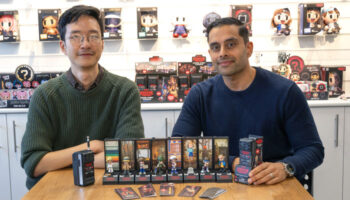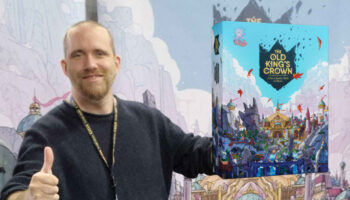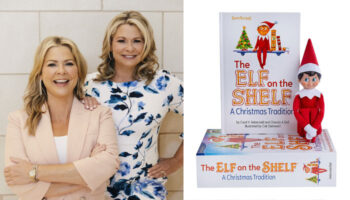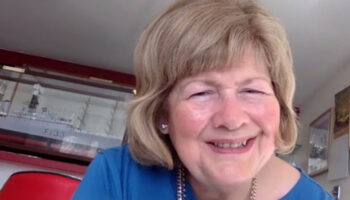Jigsaws of distinction: Rewa Walters and Sophie Morrison on Piece House’s stunning puzzles
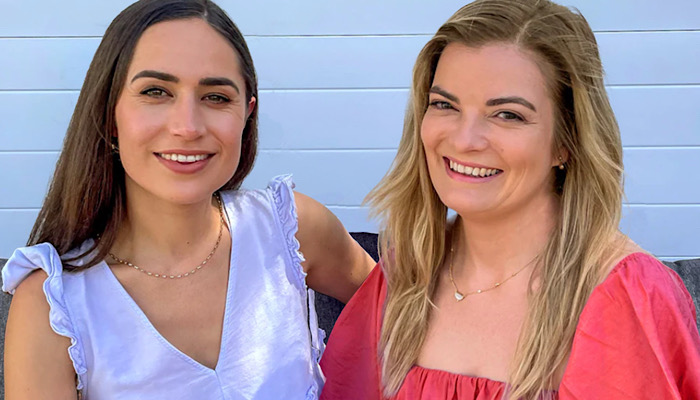
Thanks for making time. Rewa, you’ve just cycled from Clapham to Putney to be here… Sophie, you’ve come all the way from New Zealand. Just for this?!
Sophie: Ha! Yes… It’s a special meeting!
Let’s pretend that’s true! And let’s start with your very exciting names: Rewa… You did tell me, but I’ve quite forgotten: what does Rewa mean?
Rewa: It’s a Maori name; it means ‘to rise’.
To rise! Yes! And Sophie: that also has a meaning… Do you know what Sophie means?
Sophie: I think it means ‘wise’.
Why, yes it does…
Rewa: Rise and wise!
Rise and wise! Ha! It’s like a double act. And is that apt? Does one of you tend to be saying, “We’ve got to get on and do this!” while the other’s saying, “Hang on a second – let’s do the research…”
Sophie: Yes, but we both switch between those roles depending on what the task is. Whoever has the idea tends to get the other person looking at the reality of it. So if Rewa has the idea, say, I’ll be thinking about the money, what we can practically deliver, the actual logistics and the outcome. Then it’s the other way around! One of us tends to bring the other down to earth.
Makes sense. And what is the name of the company you founded?
Rewa: It’s called Piece House. It’s a jigsaw puzzle business for adults with a couple of key points of difference. One is that all our jigsaws are designed by independent New Zealand artists. We’re also taking a more modern approach to jigsaw puzzles… So rather than very traditional landscape imagery, our artists create in bright, vibrant colours. That’s really why we started the business – we found that there weren’t enough jigsaws with funky illustrations or cool artwork – particularly in New Zealand which is where we’re both from.
Excellent! And you’ve mentioned a couple of things there… First, from interviews I’ve done in the past, I know designing a jigsaw isn’t as simple as slinging a nice picture on a puzzle. How do you approach it?
Sophie: We approach it in a couple of different ways. Often, we find artists online, or on Instagram, or by seeing art in a gallery window and snapping a photo… Sometimes even when the art gallery’s closed! We’re like, “Who’s that artist? I need to see their name!”

So are you adapting existing pieces of art? Or starting from scratch?
Sophie: Both. We start some from scratch because we really like an artist’s style. For some artists, they may not have quite the right thing in place, but they’ll have shown they can do really detailed work. Whenever we see that, we think they’ll be able to get there because getting the detail is actually quite a fine art.
And how would you know if something’s right? What are you looking for?
Sophie: I think we now just have a feel for it. One sign that a design isn’t going to work in a traditional puzzle would be too much empty space. That just makes a jigsaw too hard… In a traditional puzzle, you wouldn’t want a picture with too much sky, for example. Another example might be having too much of a house, or one section of colour or a pattern. So it’s about working with the artist to bring in a gradient or an extra layer to add texture.
Presumably, then – if you’re starting from scratch – you have to direct the imagery as it comes together?
Sophie: Yes. It’s not always the easiest process because no one likes to be critiqued! So I’ll circle things and say, “We need more here and here, we need less here…” In the end though, our artists end up being really happy even if they’ve had to change quite a few things. And we often send them the final puzzle to complete for themselves. When they do them, they’re often surprised to find they’re harder than they thought they’d be.
Rewa: We want the artists to have full creative freedom to represent their style and not have to change it. But we quickly realised that we needed to give suggestions on how to adapt their artwork so that we can not just keep their look and feel but also create an incredible experience for our puzzlers.
Yes, I can imagine. Tell me about setting briefs; what kind of categories are you looking to fill?
Sophie: One key thing we do is called Kiwiana. Kiwiana is anything that’s typically New Zealand. That might be iconic landmarks, or pictures of landmarks; it might be the native birds and plants or cultural items that are associated with all things New Zealand… It’s a really strong theme for us. Obviously, that changes a little now that we’re in the UK market, but it’s always been a strong theme. So yes, I’m always looking for artists in that category.

We also have like a strong floral theme which is great for occasions like Mother’s Day. Another theme we have is kept kind of loose… We don’t have an actual word for it, but it’s something that we feel 20- to 30-year-olds would like: popular-slash-fashion-slash kind-of trendy. So I’m always making sure that I’m briefing to those three categories.
Terrific! And tell me about your new Christmas design…
Sophie: That was an interesting challenge because Christmas in the UK looks very different from Christmas in New Zealand. In New Zealand; Christmas happens in the summer! You’re on the beach, you’ve got the barbecue going and you’re in shorts. But, at the same time, we’re heavily influenced by the traditional European Christmas, which is wintery and snowy.
That means artwork on greeting cards and the like can be winter themed, but you also get a few designs that are summer themed: Santa on a surfboard or whatever. So with our new Christmas design, we needed to be able to appeal to both audiences. As a result, we decided to do an inside look and make it season neutral.
You can’t tell what season it is?
Sophie: Right. It’s more like The Night Before Christmas: think Christmas tree, drinks, presents, canapés, a sense of getting things ready… But no fire because that would suggest cold. And there’s no window! We nearly had one in there, but we would’ve had to have depicted a season outside. So it’s a wall with a garland! And funnily enough, the artist that did this for us is a Kiwi girl – but she lives here in the UK!
I know quality is really important with your product. But how would I know what a bad quality jigsaw looks like or feels like?
Sophie: The signs of a bad quality puzzle could include the artwork literally peeling back as you push the pieces together or break them apart… The image literally lifts off the board! That means it’s a one-time puzzle – there’s no point in saving it or keeping in the cupboard to do again.
Rewa: When we first started, we knew we’d need to differentiate ourselves from other puzzle companies. We set out to make a premium product that puzzlers love and would want to come back for. We also set out to make our puzzles as great gift purchases that you’d want to buy for grandma, mum, auntie, uncle – whoever it may be. As part of our research, we bought a large number of jigsaw puzzles from other brands. Then we tested their quality in terms of the printing, the packaging, the box sturdiness and putting the pieces together… We also looked at the design: what do we like? What don’t we like?

That way, we were developing our own in-house quality standards before we started. We also got a lot of ideas externally… There was a puzzle group online that had done a similar exercise. That was useful because it made it clear which elements people liked from one brand and which elements they liked from another. It was also useful to go through amazon reviews, globally, and look at the two- and three-star reviews to understand what consumers were complaining about and what’s important to them.
Two- and three-star reviews? Why not one- and five-star reviews?
Rewa: One- and five-star reviews tend to be more extreme. They often don’t review the product! The one-star reviews might be about poor customer service, say: it arrived late! The box got crushed in the mail… They sent the wrong thing. Then the five-star reviews are more like the die-hard fans. You’re nor learning as much from those extremes. We wanted to read the people in between for more balanced feedback about the brands; get a more genuine feel for what was needed in the market.
Great answer. I’m going to mention some articles about using theoretical one-star reviews here, and theoretical ‘dream reviews’ here. Now, tell me: how did you come to be doing this?
Rewa: Back in 2015, Sophie and I used to work together in the marketing team for a company that owns multiple shopping malls in New Zealand. We did a lot of activations within certain shopping centres… There were many late nights and a lot of hard work! We really understood each other’s work and working styles; we had a similar work ethic and values. Out of that, we grew a great friendship. When we left the company, Sophie started her own graphic-design agency and I came over to the UK. Even so, we thought we might start a business together…
Sophie: We’d always be exploring different ideas of what we could do! We’d brainstorm and start things up, test things out and even register names! One of them was Kubb, for example: the Swedish outdoor game in which you throw wooden batons to try and knock over wooden blocks. There are versions of that available in New Zealand, but they’re very expensive. We thought we might be able to do a cheaper version. We got as far as exploring the manufacturing – in the end, that didn’t come to anything. But all the way through this, I was a puzzler! Every week, I’d get together with two or three of my friends for a girls’ puzzle night…

Ah! I was going to ask about that! I figured one of you must’ve been very passionate about puzzles…
Sophie: Yes! The friends I’d see to do a puzzle night would change depending on who’d got a newborn, for example! Ha! But we’d go to each other’s houses, have dinner, catch up and do puzzles with a glass of wine. Then we’d roll it up, go home and see each other at a different house the next week!
As a result of that, we always needed new puzzles – and I kind of felt that there were no cool new ones. Then, about four years ago – during the lockdowns – Rewa and I spoke on the phone about whether or not there was a business there. And we pretty quickly felt that there was. We quickly started researching it and planning out a logo and so on. And it took off from there.
Amazing! I love that your friendship survived and thrived after you stopped working together; that’s quite rare. To wrap things up, tell me: what’s the one thing I could’ve asked you today that I didn’t?
Rewa: Oh, that’s a good question! Sophie? Ha!
Ha! “Soph?” Come on! You’re supposed to be wise!
Sophie: Ha! Maybe: “What’s in the near future for Piece House?”
And what IS in the near future for Piece House?
Sophie: So the near future for Piece House includes a couple of things that we’re excited about. One is that we’re introducing a couple of puzzles that move away from the traditional rectangle… We’ve created a mould of a hexagon shaped puzzle with a funky shaped piece in the cent, which is very different. That’s going to be a 500-piece puzzle.

A hexagon? Now that is unusual! I don’t think I’ve seen that before…
Rewa: The Christmas design we spoke about before is a hexagon… But that’s not as simple as just printing an image on a different shape! It’s much harder to produce than you might think. You really have to look at the dieline and how things connect. It’s taken us a very long time to perfect; it’s a labour of love. And in conjunction with that, something else we’re exploring is the world of speed puzzling…
Ah! Yes, you went to a competition in Spain recently, did you not?
Sophie: Yes! We were in Valladolid a few weekends ago, at the 2025 World Jigsaw Puzzle Championship. That’s a competition for individuals in which they typically use a 500-piece puzzle… You have an hour to complete it. Obviously, you don’t know exactly which puzzles you’re going to be offered to complete, so you have to practice with your own 500-piece puzzles! But it’s a really interesting community that we’d like to get more involved in. There’s also another kind of speed puzzling, which is a more trust-based, mass market model… There, people buy a new jigsaw design, record their own time doing it and then upload it.
Fantastic! Well, thank you both, Rewa and, Sophie; the rise and the wise… Lovely to speak with you. The product looks great, so come back and keep us posted, won’t you?
–
To stay in the loop with the latest news, interviews and features from the world of toy and game design, sign up to our weekly newsletter here





